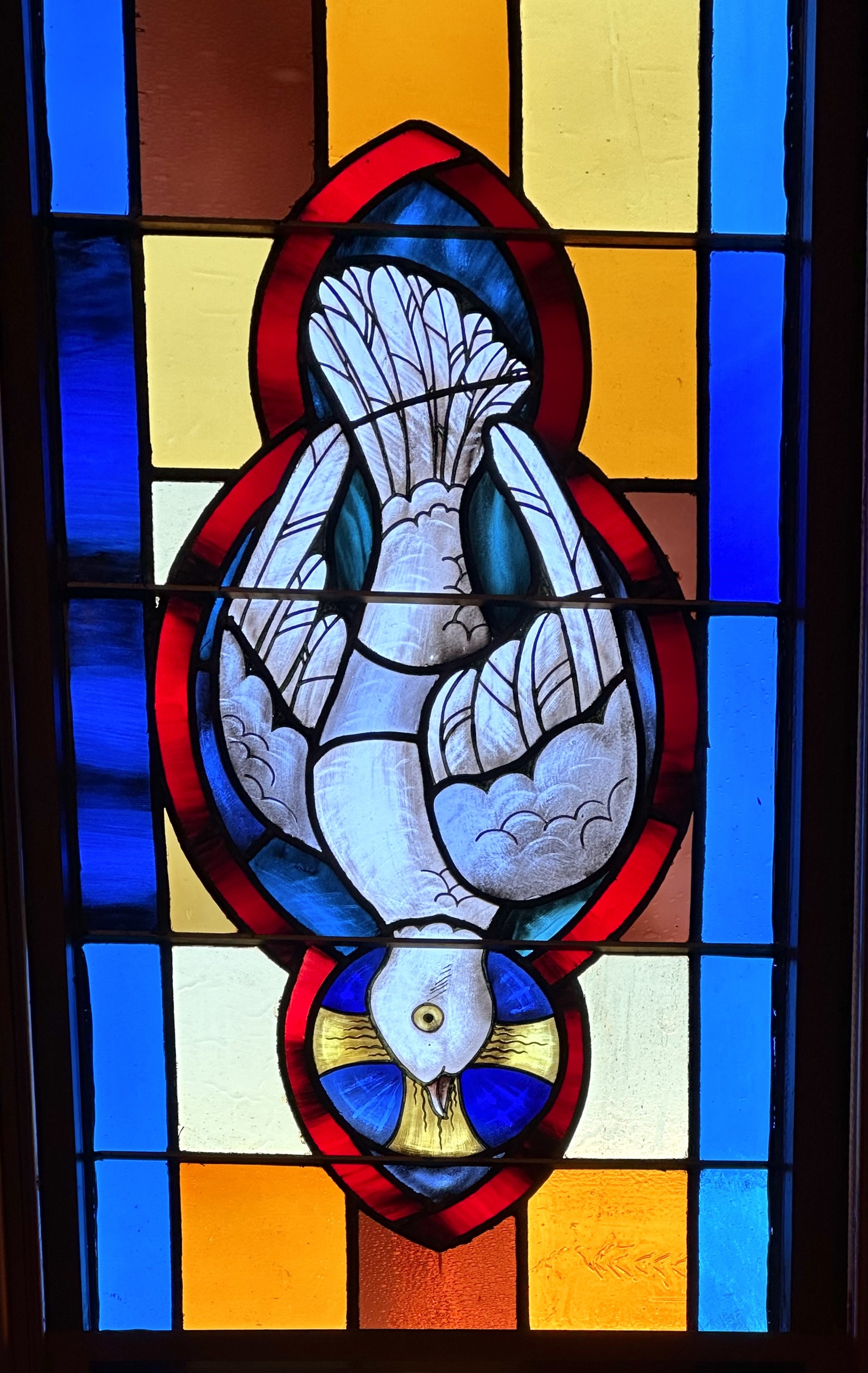
Symbols
In
Stained
Glass
For centuries, churches have used stained glass windows to teach worshipers about important Bible stories and concepts. The United Church of Fayetteville’s sanctuary windows follow this tradition by using historic symbols with Christian significance.
Baptism and the Descending Dove
Depicted together, these two symbols remind us of Jesus’ baptism by John in the Jordan River. According to scripture, the dove symbolizes the Holy Spirit, which appeared over Jesus: “…he saw the Spirit of God coming down like a dove and resting on him.” (Matthew 3:16) Christian Baptism uses water to symbolize being washed clean of sin and renewed by the grace of God. The seashell, sometimes used to scoop water on the person being baptized, has been associated with baptism since the first centuries of the Christian church.
The Anchor
Clement of Alexandria is said to have approved the use of the anchor as a symbol because of its use in scripture: “We have this hope as an anchor for the soul, firm and secure." (Hebrews 6:19) This verse ties the anchor to the concept of "hope," and thus Christians' hope of salvation through Christ.
The Crown
The crown represents Jesus Christ as the heavenly King and also symbolizes eternal life, the reward of the faithful who believe in Christ. “Be faithful even to the point of death and I will give you the crown of life.” (Revelation 2:10)
The Alpha and the Omega
The first and last letters of the Greek alphabet signify that Jesus is the beginning and the end of all things, eternal. “’I am the Alpha and the Omega,’ says the Lord God, ‘the one who is and was and is coming, the Almighty.’” (Revelation 1:8; 21:6 and 22:13) The New Testament was written in Greek, the language of educated people across the world at that time, and the Alpha and Omega symbols were used in early Christianity. They are often depicted side-by-side, but on UCF’s window they are intertwined.
The Celtic Cross
Crosses are the most common symbol of Christianity, reminding us of Jesus’ crucifixion. UCF’s Celtic Cross features a decorative interlaced pattern and a circle surrounding the intersection, making it a Celtic Cross. Circles often represent a halo, the Son, or eternity, because they have no beginning or end.
The Lamp
This window depicts a lamp used in ancient times to burn olive oil for light and would be similar to the one to which Jesus refers in his parable of the foolish bridesmaids who didn’t bring oil to refill their lamps (Matthew 25:1-13). Light is frequently used in the Bible as a symbol for God, Jesus, or the Word of God; sources of light and fire, such as lamps and candles, thus have become common Christian symbols.
The Trinity Knot
The Christian doctrine of the Trinity defines God as three persons: the Father, the Son (Jesus Christ), and the Holy Spirit, “One God in three persons.” The three equal arcs of the trinity knot symbol express eternity in their continuous form, indivisibly in their interweaving. At their center is a triangle, an ancient symbol for the Trinity, three beings of power, honor and glory, but indivisibly one God.
The Grapes and Wheat
The grapevine and the stalks of wheat appear in both the round window over the door by the chancel and the first window on the west side. Grapes and wheat symbolize the two elements of the Lord’s Supper or Communion, the wine and bread, which in turn symbolize the blood and body of Christ, sacrificed for us.
The Fish
The fish has multiple symbolic meanings for Christians. Jesus called Simon Peter, Andrew, James and John from their work as fishermen to be his Disciples, or “fishers of men.” (Matthew 4:19) Later, Jesus divides a small boy’s five loaves of bread and two fish that Jesus divided to feed a multitude of 5,000 who had gathered to hear him preach. (John 6:1-14) Early Christians being persecuted used a simple fish design as a secret sign to identify themselves to other Christians.
The Triumphant Lamb
The lamb symbolizes purity and innocence. It was a sacrificial animal of atonement for the Hebrew people and its features prominently in the Passover story in Exodus. The Passover ritual foreshadowed the sacrifice of Jesus for all people. When John the Baptist first saw Jesus, he said: “Look! The Lamb of God that takes away the sin of the world!” (John 1:29) The lamb in UCF’s window stands with a banner upon a cross, representing the risen Christ triumphant over death.
The Ship With a Cross on the Sail
The ship symbolizes the church, and the red cross on a white sail symbolizes victory. Thus, this is a picture of the Church Triumphant, sailing unharmed through a stormy sea. Just as God protected the faithful in Noah’s ark and Jesus protected his faithful in a boat on the Sea of Galilee, the ship reminds us that the faithful will be protected during the storms of life.
The Dove
Doves often symbolize peace, but the three yellow rays coming from the head of this dove identify it as a symbol of the Holy Spirit, a member of the Trinity , along with God the Father and Jesus Christ the Son. The Holy Spirit, depicted as a dove, is often shown descending from the sky (or heaven), as it did upon Jesus during his baptism.













